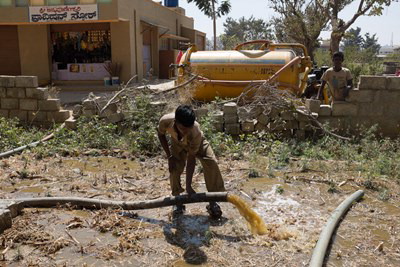|
|
Cycle 2 (2012 Deadline)
Fecal sludge and urine reuse in agriculture: opportunities for addressing phosphorus needs in India PI: Pay Drechsel (International Water Management Institute), with co-PI P. Sudhakar (Haritha Association for Learning from Environment) (Years 1 and 2 co-PI Dr. Vijayaraghavan Chariar, Indian Institute of Technology-Delhi) U.S. Partner: James Elser (Arizona State University)
Project Dates: August 2013 to May 2017 (portion at IWMI completed June 2016)
Project Overview
![2-475_focus group discussion with farmers]()
Focus group discussion with farmers. (Photo courtesy Dr. Drechsel).
|
India’s rapid urbanization and population growth have made food security a high policy priority and is putting significant pressure on the agriculture sector, where poor and marginal farmers especially suffer from high fertilizer prices. It is therefore imperative for India to explore alternative nutrient sources. With changing resource flows to cities, urban waste offers a variety of options for resource recovery.
Farmers in the states of Karnataka and Andhra Pradesh, as well as other parts of Southern India, are already using fecal sludge from urban on-site sanitation facilities. The informal sector has turned widespread lack of treatment facilities for sludge derived from septic tanks from a serious environmental burden into an agricultural asset. The sludge comes straight from the septic tanks and instead of being dumped into rivers, is dried on farms before use, mostly on plantation crops. Considering the declining global phosphorus reserves, treated fecal sludge, and in particular urine, can constitute a significant source of phosphorus for crops. However, the practice is not without environmental risks. More data are needed to understand the current scale of reuse, environmental tradeoffs, and limitations and to advise authorities on options for how to safeguard human and environmental health.
An existing International Water Management Institute project in Karnataka supported the establishment of business models for sludge reuse, safe reuse guidelines, and Sanitation Safety Plans through stakeholder dialogues. This PEER project fed data into the dialogue and contributed to knowledge dissemination, including empirically based recommendations on phosphorus recovery from otherwise wasted resources and preventing water pollution and a key public health threat.
Final Summary of Project Activities 
A worker pours fecal sludge onto farmland (Photo courtesy Dr. Drechsel).
|
Researchers visited 12 cities in four regions of India to understand the feasibility of carrying out research on fecal sludge management, especially given it happens largely in the informal sector. City officials, truck operators, sanitation workers, farmers, farm workers and nearly thirty different organizations working in sanitation sectors were interviewed. The team selected four cities in Southern India to better understand business practices surrounding fecal sludge management: Bangalore, Mangalore, Guntur, and Dharwad. PhD student Sharada Prasad interviewed sanitation workers and extensively surveyed 3,000 farmers and farm workers on perceptions related to fecal sludge reuse. He then analyzed and interpreted the data, publishing several papers and a PhD dissertation on the results, including on health risks associated with fecal sludge reuse, opportunities and barriers related to fecal sludge reuse in agriculture, and a review of demand for and supply of phosphorus in Indian agriculture.
The PEER team, in partnership with Arizona State University (ASU), organized two roundtables on policy interventions, technology development, and curriculum development in sustainable sanitation. The roundtables focused on identifying pertinent problem areas, exploring funding opportunities and co-developing solution pathways in consultation with relevant stakeholders. ASU has developed several new India partnerships as a result.
Researchers also undertook additional surveys of homeowners, fecal sludge truck operators, and municipal authorities. As part of the PEER project, two team members researched and finished thesis work in their graduate studies: one on sustainable sanitation systems in rural Indian villages and one on various technologies for nutrient recovery through human urine.
Publications
C.S. Sharada Prasad and Isha Ray. 2019. When the pits fill up: (in)visible flows of waste in urban India. Journal of Water, Sanitation and Hygiene for Development 9(2): 338-347. https://doi.org/10.2166/washdev.2019.153
B. Mayer, L. Baker, T. Boyer, P. Drechsel, M. Gifford, M. Hanjra, P. Parameswaran, J. Stoltzfus, P. Westerhoff, and B. Rittmann. 2016. Total Value of Phosphorus Recovery. Environmental Science & Technology 50: 6606−6620. https://doi.org/10.1021/acs.est.6b01239
Md Azizur Rahman and V.M. Chariar. 2016. Process Optimization for Sequential Recovery of N, P and K from Human Urine. South Asian Journal of Experimental Biology 5(6): 205-221. http://dx.doi.org/10.38150/sajeb.5(6).p205-221
S. Ramesh Sakthivel, Md Azizurrahaman, V. Ganesh Prabhu, and V.M. Chariar. 2016. Performance evaluation of a low-cost odour trap installed in waterless urinals. Journal of Water, Sanitation and Hygiene for Development 6(2): 252–258. https://doi.org/10.2166/washdev.2016.151
Md Azizur Rahman, Vijayaraghavan M Chariar. 2015. Optimization of Urea Hydrolysis from Human Urine and Efficacy Comparison of Different Experimental Designs. International Journal of Environmental Sciences 4(3 and 4): 110-124.
Md Azizur Rahman, S. Ramesh Sakthivel, and V.M. Chariar. 2014. Techno-economic assessment of Ecosan inspired technologies for recovery of nutrients from human urine for ecological sanitation. International Journal of Environmental Sciences 3(4): 205-220.
Link to video of a January 2015 project presentation by Sharada Prasad: https://youtu.be/4ZW9jCqvUS8?t=14m50s.
|
|
|
|




